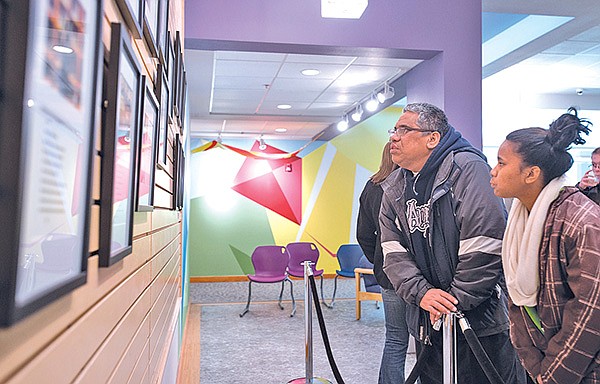Springdale Students Show Projects At Library
Projects To Be On Display Throughout The Month
STAFF PHOTO ANTHONY REYES Labi Anni and his daughter Susie Anni, 14, look at her project Monday at the Arkansas Studio Project opening at the Springdale Public Library. The project is a literacy program that helps Springdale students who are underserved and low income showcase art projects. The projects will be on display until the end of the month.
Tuesday, February 11, 2014
SPRINGDALE — Nicholle Pierce said her project and photo about child abuse have inspired her to want to help children as part of her future career.
Nicholle, 13, is in seventh grade at J.O. Kelly Middle School and a photo she took of her 6-year-old sister posed under a chair is hanging in the gallery at the Springdale Public Library. It’s surrounded by the work of other Springdale students.
The gallery was filled with chatter Monday evening as students, parents and teachers looked at the artwork displayed on the walls as part of the Arkansas Studio Project. People pointed their phones at QR codes, digital bar codes that can be scanned with a smartphone, next to a few pieces of artwork and listened to the downloaded podcasts. Others read essays and poems that accompanied the photography.
Fast Facts
Literacy In America
Fifteen percent of low income eighth-graders read at a proficient level.
Eighty-five percent of juveniles who have committed crimes have problems with reading.
More than 8 million students in fourth through 12 grade read below grade level.
Three percent of eighth-graders read at an advanced level.
About 40 percent of high school graduates don’t have the literacy skill employers want.
African American and Hispanic twelfth-graders generally read at the same level as eighth-graders.
Source: reading.org
About 40 Springdale students in grades six through 12 worked on projects throughout the fall 2013 semester, and the art is on display at the library, said David Kinzer, site coordinator at George Junior High and Springdale High School for the Arkansas Studio Project. Student projects include photos, self-portraits and podcasts. Each project has an accompanying written section, such as a podcast script, poem or essay.
The Arkansas Studio Project, previously called Razorback Writers, is an organization through the Center For Children and Youth at the University of Arkansas, said Hung Pham, director of the project. The goal of the project is to promote literacy among low income and minority students by partnering with teachers at Springdale High School, George Junior High, Southwest Junior High and J.O. Kelly Middle School.
Hands-on projects, like those displayed at the library, are good for students because they promote creation and interaction in the learning process, Kinzer said. It helps get them excited about learning.
“In general, we try to promote student expression,” he said.
Officials with the project try to incorporate art into the lessons and projects, because students tend to get excited about learning when art is involved, Pham said. The project focused on photography and poetry in fall 2013.
Hands-on projects are important for students, because there’s a goal to reach, and it allows them to challenge themselves, Pham said. Working on projects also allows students to be proud of what they have created.
Working on a project is not just about learning something, it’s about doing something, said Kim Garrett, assistant superintendent for teaching and learning grades eight through 12 in the Springdale School District. Completing a project makes students be more active and less passive when it comes to learning.
Nicholle said she chose the topic of child abuse because she had read a few stories on the topic, and it affected her emotionally. She hopes to be able to educate the public about the seriousness of child abuse through her project.
Projects also promote literacy, because they generally require students to do research and write about the subject, Garrett said.
“When we write it down, we really begin to understand it,” she said.
Nicholle said it took her six to nine hours of reading to do all of the research for the podcast part of her project. She then spent two to four days working on an essay and three days working on the script for the podcast.
Timothy Pierce, Nicholle’s father, said she spent a lot of time at home working on the project. He said child abuse was a difficult subject, but he’s glad she has learned to be thankful for what she has in life.
“Sometimes you want to shelter your kids from what’s out there, but it’s good that she learned that life’s not perfect,” he said.
Working on a project to put on display for the public to see also teaches students that they need to be aware of their audience, whether it’s a teacher, other students or the community, Pham said.
“All work has an audience,” he said.
Marje Salik, 16, said having her writing and photos on display for the public to see motivated her to do her best work. She was nervous at first when she found out her work would be on display. Now that she has seen it at the library, she said it feels good to have community members looking at it.
It’s good for students in the district to learn from the Arkansas Studio Project, because it’s another source of knowledge with a different perspective, Garrett said. She compared it to a child being told something by their parents and not believing it until another adult says the same thing.
The library also worked with the project last year, when it was called Razorback Writers, to display student art, said Vilma Martinez, multicultural outreach coordinator. The projects were placed in the library’s gallery on February 3 and will be on display throughout the month.
